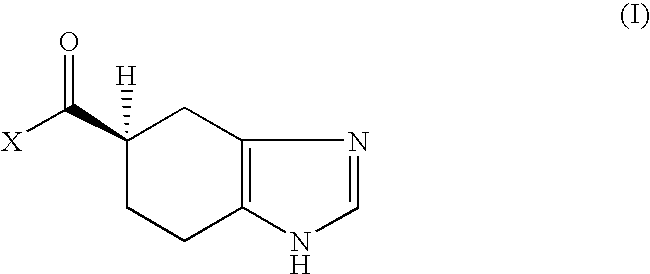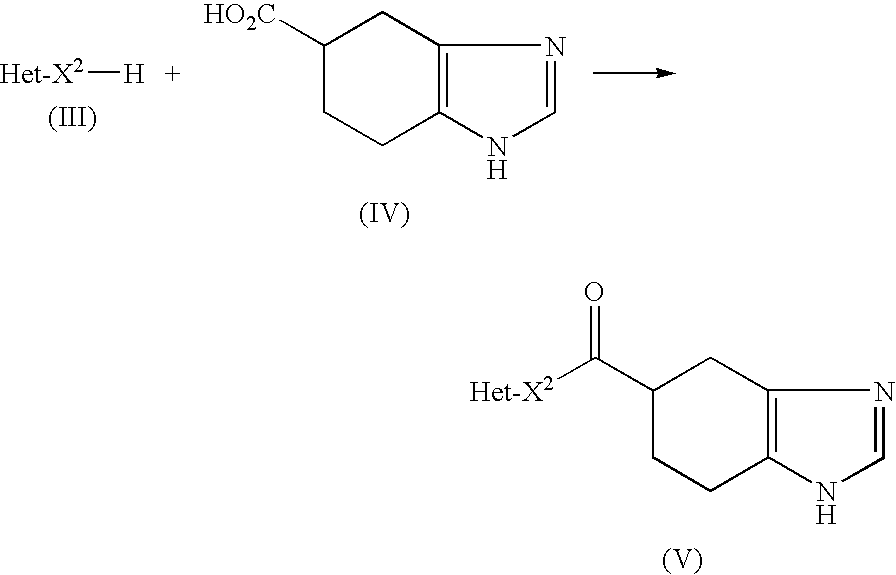Novel Process for Producing Ramosetron or Its Salt
a technology of ramosetron and ramosetron salt, which is applied in the field of new ramosetron or salt production process, can solve the problem of not disclosing the production method of nor-ym060, and achieve the effects of increasing optical purity, high yield and high optical purity
- Summary
- Abstract
- Description
- Claims
- Application Information
AI Technical Summary
Benefits of technology
Problems solved by technology
Method used
Image
Examples
example 1
[0060]By heating a mixture of 4.05 g of (R)-4,5,6,7-tetrahydro-1H-benzimidazole-5-carboxylic acid monohydrochloride (99.4% e.e.), 120 ml of dimethoxyethane and 5.47 g of thionyl chloride at 70° C. for 2 hours, (R)-4,5,6,7-tetrahydro-1H-benzimidazole-5-carbonyl chloride was synthesized, and the solvent was evaporated under a reduced pressure. A 80 ml portion of toluene was added to the residue and again evaporated under a reduced pressure, and the residue was mixed with 120 ml of toluene and 5.24 g of 1-methyl-1H-indole and cooled to −40° C. in an atmosphere of nitrogen. A 30 ml portion of 1.0 mol / l toluene solution of ethylaluminum sesquichloride was slowly added to this liquid and stirred at −40° C. for 3 hours, and 10 ml of tetrahydrofuran was added thereto after the stirring. This liquid was slowly dispersed in 160 ml of water cooled at 0° C., and after removing the organic layer, the water layer was washed with 40 ml of toluene and extracted by adding 80 ml of 2-butanone and 50 ...
example 2
[0063]By heating a mixture of 4.05 g of (R)-4,5,6,7-tetrahydro-1H-benzimidazole-5-carboxylic acid monohydrochloride (99.4% e.e.), 120 ml of dimethoxyethane and 5.47 g of thionyl chloride at 70° C. for 2 hours, (R)-4,5,6,7-tetrahydro-1H-benzimidazole-5-carbonyl chloride was synthesized, and the solvent was evaporated under a reduced pressure. A 80 ml portion of toluene was added to the residue and again evaporated under a reduced pressure, and the residue was mixed with 120 ml of toluene and 5.24 g of 1-methyl-1H-indole and cooled to −25° C. in an atmosphere of nitrogen. A 33 ml portion of 1.8 mol / l toluene solution of diethylaluminum chloride was slowly added to this liquid and stirred at −25° C. for 2 hours, and 8 ml of tetrahydrofuran was added thereto after the stirring. This liquid was slowly dispersed in 100 ml of water which was cooled at 0° C., and then heated to 45° C. After removing the organic layer, the water layer was washed with 40 ml of toluene, and this was extracted ...
PUM
| Property | Measurement | Unit |
|---|---|---|
| pH | aaaaa | aaaaa |
| optical purity | aaaaa | aaaaa |
| optically active | aaaaa | aaaaa |
Abstract
Description
Claims
Application Information
 Login to View More
Login to View More - R&D
- Intellectual Property
- Life Sciences
- Materials
- Tech Scout
- Unparalleled Data Quality
- Higher Quality Content
- 60% Fewer Hallucinations
Browse by: Latest US Patents, China's latest patents, Technical Efficacy Thesaurus, Application Domain, Technology Topic, Popular Technical Reports.
© 2025 PatSnap. All rights reserved.Legal|Privacy policy|Modern Slavery Act Transparency Statement|Sitemap|About US| Contact US: help@patsnap.com



